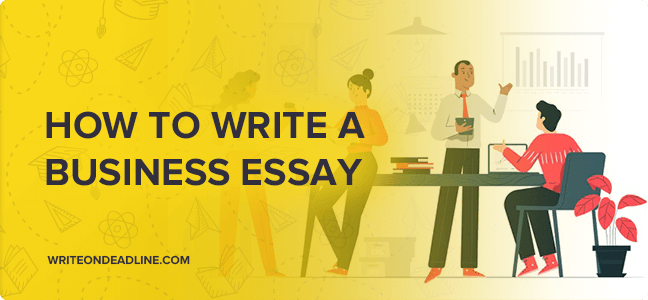How to Write a Business Essay

Table of Contents
What is a Business Essay?
A business essay is a written analysis or interpretation of a particular business-related question or problem. Its main purpose is to present a compelling argument, supported by evidence, to persuade or inform its readers about a specific aspect of business, whether it be management, marketing, finance, ethics, or any other business-related topic.
Overview of Different Types of Business Essays:
- Analytical Essays: These essays dissect a business scenario or problem, analyze the components, and present the findings in a structured manner.
- Persuasive Essays: Aimed at convincing the reader about a particular point of view or business strategy. These require strong arguments and supporting evidence.
- Case Studies: These essays involve a detailed examination of a particular company or event. The writer explores the subject’s background, present conditions, and potential future implications.
- Comparative Essays: These contrast two or more items, such as different leadership styles, market strategies, or economic theories, to understand their distinctions and implications.
- Problem-Solution Essays: Identify a problem within a business context and propose a feasible solution, backing it up with factual evidence and analysis.
Understanding the Assignment:
Tips for Comprehending Essay Prompts and Instructions:
- Read Carefully: Take time to read through the essay prompt several times to understand precisely what is being asked.
- Highlight Keywords: Identify action words such as “analyze”, “compare”, “critique”, or “discuss” to grasp the type of response required.
- Clarify Doubts: If anything is unclear, do not hesitate to seek clarification from the instructor or peers.
Importance of Identifying the Essay’s Objectives and Audience:
- Objectives: Understanding the purpose of your essay is crucial. Is it to inform, persuade, or analyze a business concept or strategy? Knowing this guides your research and writing process.
- Audience: Knowing who will read your essay (e.g., academics, business professionals, peers) helps tailor the language, complexity, and tone of the content to suit their level of understanding and interest.
Research and Analysis:
How to Conduct Thorough Research Using Credible Sources:
- Library and Online Databases: Utilize academic libraries and online databases for reputable sources such as journals, books, and authoritative articles.
- Government and Industry Reports: These can provide reliable statistics and insights.
- Case Studies and Company Records: Great for specific insights and real-world evidence.
Methods for Analyzing Information Relevant to the Essay Topic:
- Create an Outline: This helps organize thoughts and data logically.
- SWOT Analysis: Evaluate strengths, weaknesses, opportunities, and threats related to the essay topic.
- Comparative Analysis: If applicable, compare different theories, case studies, or data sets to draw informed conclusions.
- Critical Thinking: Challenge assumptions and explore alternative viewpoints. This deepens the analysis and strengthens arguments.
In the following sections, we will delve deeper into how to structure your essay effectively, develop a robust argument, and polish your work through careful editing and proofreading.
Planning and Outline:
Creating a Robust Business Essay Outline:
A well-structured outline serves as the backbone of your essay. It can be detailed or brief, but it should clearly map out the introduction, body paragraphs, and conclusion.
- Thematic Organization: Group your research findings into themes or categories that will become the basis for your paragraphs or sections.
- Sequential Flow: Ensure that there is a logical progression of ideas from one paragraph to the next.
- Balance: Allocate a proportional amount of content for each section according to its importance in supporting your thesis.
Strategies for Organizing Thoughts and Research Findings:
- Mind Mapping: Use this to visually organize your thoughts around the central topic.
- Bullet Lists: Make simple bullet lists to arrange facts and arguments in order of impact or relevance.
- Post-it Notes: These can be rearranged easily to help you decide on the best structure for your essay.
Writing the Business Essay Introduction:
Crafting a Compelling Opening Statement:
- Hook: Begin with a strong hook that captures the reader’s attention, such as a striking statistic, a rhetorical question, or a relevant anecdote.
- Relevance: Briefly relate the opening to the wider business context to show the significance of your essay topic.
Establishing Context and Stating the Thesis:
- Background Information: Provide a concise overview of the topic’s background necessary for understanding the ensuing discussion.
- Thesis Statement: Clearly articulate your thesis, presenting your central argument or stance, which the rest of your essay will support.
Body Paragraphs:
Structuring Arguments Logically:
- Topic Sentences: Start each paragraph with a topic sentence that presents the main idea of the paragraph.
- Coherence: Make sure that each sentence flows logically from one to the next, maintaining coherence within and between paragraphs.
Use of Evidence and Examples to Support Points:
- Credible Evidence: Support your arguments with data and evidence from credible sources.
- Real-World Examples: Incorporate examples from actual business practices to illustrate your points more vividly.
- Explanation: Don’t just present evidence, but also explain how it supports your argument or relates to your thesis.
Concluding the Business Essay:
Techniques for Summarizing the Main Points Effectively:
- Restate the Thesis: Reinforce the thesis statement, putting it in the context of the provided evidence and arguments.
- Summarize Key Arguments: Recap the key points made in the body, highlighting how they collectively support your thesis.
Discussing Implications, Recommendations, or a Call to Action:
- Implications: Discuss the broader implications of your findings or argument for the business world or a specific sector.
- Recommendations: If appropriate, offer well-grounded recommendations for action or further investigation.
- Final Thought: Leave the reader with a provocative final thought or question to underscore the essay’s significance and encourage further reflection.
The conclusion of your essay is not merely an endpoint but a decisive component that ties together your analysis, reinforcing the significance of your argument and its implications in the business field.
Referencing and Citation:
Guide to Proper Referencing Styles Commonly Used in Business Essays:
- APA (American Psychological Association): Often used for business, psychology, and social sciences, it focuses on the author-date method of in-text citation.
- Harvard: A common author-date reference style where the citations are parenthetical, with a reference list at the end.
- Chicago: Known for its footnote or endnote style, but also has an author-date system; prevalent in history and some business publications.
- MLA (Modern Language Association): Utilizes parenthetical citation; less common in strict business fields but sometimes used in business humanities.
To correctly format citations and references, refer to the specific style guide or use citation tools like Zotero, EndNote, or Mendeley.
Importance of Avoiding Plagiarism:
- Ethical Writing: Presenting others’ words or ideas as your own is unethical and can lead to severe academic and professional consequences.
- Originality: Original work is valued and demonstrates your own understanding and analysis of the topic.
- Credibility: Proper citation builds credibility and allows readers to verify sources, fostering trust in your analysis.
Editing and Proofreading the Business Essay:
Best Practices for Revising the Essay:
- Multiple Rounds: Go through several rounds of editing, focusing on different aspects each time—structure, argument flow, evidence, and then language.
- Peer Review: If possible, have a peer review your essay for fresh perspectives on content and clarity.
- Distanced Review: After writing, take a break before editing to review your work with fresh eyes.
Grammar, Punctuation, and Style Considerations:
- Consistency: Ensure consistent use of tense, voice, and person throughout your essay.
- Clarity and Brevity: Use clear and concise language; avoid jargon unless your audience is familiar with it.
- Punctuation and Grammar: Use tools like Grammarly or Hemingway Editor to catch common mistakes, or consult grammar guides for complex issues.
Business Essay Writing Tips:
- Understand the Business Lingo: Familiarize yourself with business terminology to make your essay more authoritative.
- Active Voice: Prefer active voice over passive for clarity and dynamism.
- Real-Life Application: Always consider how theoretical concepts apply in real-world business scenarios for more impactful writing.
- Critical Analysis: Go beyond describing concepts; analyze and critique them to add depth to your essay.
- Stay Updated: Use current examples and case studies, as the business world is continually evolving.
Additional Resources:
- Books: “The Elements of Style” by Strunk and White for style, “On Writing Well” by William Zinsser for nonfiction writing.
- Online Guides: Purdue OWL for comprehensive writing resources, Harvard Business Review for real-world business insights.
- Tools: Google Scholar for research, Grammarly for grammar checks, Turnitin for plagiarism detection.
- Databases: Business Source Complete, JSTOR, and SSRN for scholarly articles and publications.

